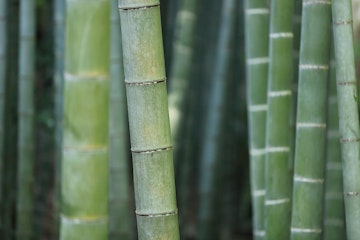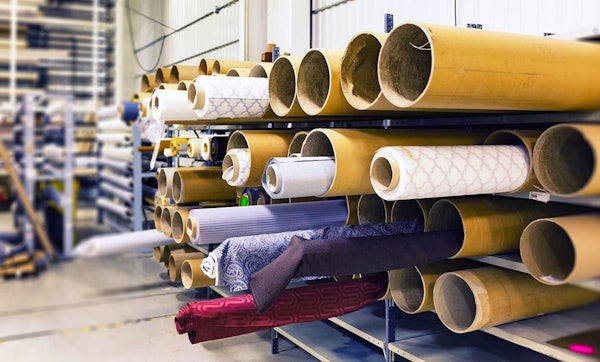Are you someone who loves clothes? Perhaps you like to play with different colors, or you enjoy the feel of soft cashmere? Maybe you like how a certain item of clothing makes you feel, boosting your mood or giving you confidence?
Besides protecting us from the elements, clothing is a powerful tool that helps us express ourselves and shape our identity.
But what are our clothes actually made out of? And what is the environmental and social cost of the clothes we wear?
Given that the fashion industry accounts for 8-10% of the world’s carbon dioxide emissions and about 20% of the world’s waste water, is creating enormous amounts of fabric waste, and is contributing to the spread of microplastics, it is important to think about the effects our fashion choices and habits have on the planet.
In order to help you make the most environmentally-friendly clothing choices, we have compiled a list of fabrics and their environmental impact, loosely rated from best to worst. We have also made some suggestions for sailors to make sure they can set sail decked out in sustainable gear. So, let’s get started!
- Plant-based Fabrics (VEF)

Plant-based fabrics are generally more sustainable than synthetic fabrics as they are renewable, biodegradable (if not blended with synthetic materials) and do not produce microplastics. Plant-based fabrics also don’t have many of the ethical issues related to animal-derived fabrics like leather or wool.
However, not all plant-based fabrics are created equal, as some require huge amounts of water and chemicals to produce. Using recycled plant-based fabrics is therefore always a better option than buying clothing made out of new fabrics.
- Organic hemp does not require large amounts of water or pesticides, it can be grown all over the world and it even fertilizes the soil it grows in. It grows very quickly and it naturally reduces pests. In addition, it does not require a lot of land, so hemp offers a high yield for the space needed. These reasons make it one of the most sustainable fabrics out there.
Certifications to look out for are: USDA-Certified Organic, Global Organic Textile Standard (GOTS), Organic Content Standard (OCS), Oeko-Tex 100, and Bluesign
- Organic linen is made from the flax plant and does not require high-quality soil, many pesticides, or much water. It’s biodegradable if left untreated, is durable and strong, becoming stronger when wet than dry, and softer the more it is washed. The flax plant is also very versatile and every part of the plant can be used (to produce linseed oil, flaxseed oil, and so on).
Certifications to look out for are: USDA-Certified Organic, Global Organic Textile Standard (GOTS), Organic Content Standard (OCS), Oeko-Tex 100, and Bluesign
- TENCEL® lyocell is officially a brand name but the fabric is commonly just called tencel or lyocell. Being a type of rayon like viscose and modal, it’s derived from wood pulp from eucalyptus trees. Unlike viscose and modal, however, its wood pulp is sustainably sourced and the chemicals used to dissolve the wood pulp are recycled in a closed system. It requires less energy and water to produce than cotton, and if not blended with other materials, it is biodegradable as well.
Birla is another company that produces sustainable lyocell, which they call Excel.
- Bamboo is a very fast-growing plant and doesn’t require fertilizer. It self-regenerates from its own roots and uses fewer resources than cotton. It can be turned into a more coarse ‘bamboo linen’ but this process is expensive and less in demand to the softer bamboo fabrics (essentially viscose/rayon), which are very breathable and much stretchier than cotton.
However, these softer bamboo fabrics require large amounts of chemicals to produce like viscose and rayon, and often land is cleared in biodiverse areas to make way for bamboo. Some companies like Lenzing produce sustainable bamboo fabric by keeping the chemicals used in a closed loop (Monocel®).
Certifications & Standards to look out for are: Forest Stewardship Council, USDA-Certified Organic, Global Organic Textile Standard (GOTS), Organic Content Standard (OCS), Fair Trade, Oeko-Tex 100, and Bluesign
- Cotton is soft and breathable, absorbs moisture easily, and is biodegradable and hypoallergenic, which is why it is loved by so many people.
However, it is very resource-intensive, requiring huge amounts of water, chemicals and pesticides. A lot of cotton is also genetically modified to make it more resistant to pests, but farmers still need to use pesticides and purchase expensive genetically-modified cotton seeds. Cotton also has a long history of slavery and continues to be linked with modern-day slavery.
A sustainable option is organic cotton, as it does not use harmful pesticides and chemicals like conventional cotton, and organic cotton seeds are cheaper than genetically modified cotton seeds. Certifications to look out for are USDA-Certified Organic, GOTS Certification, Organic Content Standard (OCS), BCI Standard, Fair Trade, Bluesign, and Oeko-Tex 100.
Recycled cotton is the most sustainable option as it uses less energy and resources than new and even organic cotton. Certifications to look out for are: Global Recycle Standard (GRS), Recycled Content Standard (RCS), and Oeko-Tex 100.
- Modal is a semi-synthetic fibre that is breathable and absorbent. It is made out of similar materials as viscose/rayon (wood pulp from beech trees) but goes through another process to make it stronger, lighter and more breathable than traditional rayon/viscose.
However, it faces similar sustainability criticism as viscose/rayon, as the wood pulp is often not sourced in a sustainable way and the production process requires a large amount of chemicals (though still fewer chemicals than rayon/viscose).
TENCEL™ Modal by Austrian company Lenzing is one sustainable manufacturer of modal, using sustainably sourced beech trees from Europe and using 10-20 times less water than conventional cotton.
- Viscose/ Rayon is another semi-synthetic fibre made from the wood pulp of fast-growing trees (eucalyptus, beech, pine, bamboo, soy and sugar cane). Like modal, the plant pulp is then dissolved in chemicals, including carbon disulphide which poses health risks to factory workers. Its production also requires large amounts of water, and the way the wood and plants are grown can furthermore often disadvantage the environment and local people.
But, there are also some sustainable viscose/rayon fabrics, such as EcoVero, which reuses chemicals in a closed loop.
- Animal-derived fabrics

Many animals in the textile industry are treated inhumanely and/or are killed, making these kinds of fabrics more unsustainable from an ethical standpoint. The resources required to produce wool or leather also have a large impact on the environment, and animal farming produces enormous amounts of methane, a much stronger greenhouse gas than carbon dioxide.
However, animal-derived fabrics can be sustainable when recycled and if the animals producing the fabrics are treated humanely. Furthermore, if not mixed with synthetic fabrics or coated in toxic dyes, animal-derived fabrics are also biodegradable and don’t produce microplastics. Leather and Down feathers are also more sustainable options if they are a byproduct of the meat industry rather than the main product.
- Yak wool, retrieved from yaks which live in the Himalayan region, is very sustainable as yaks shed naturally, so retrieving the wool does not harm the animals. It’s also very soft and warm and provides extra income to yak herders.
Certifications & Standards to look out for are: Fair Trade, Oeko-Tex 100, Responsible Wool Standard (RWS)
- Alpaca wool is generally considered to be more sustainable than sheep’s wool, as alpacas tend to be treated better, and they also don’t destroy the environment as much as sheep.
Certifications & Standards to look out for are: Global Organic Textile Standard (GOTS), Fair Trade, Responsible Wool Standard (RWS), Woolmark, and Climate Beneficial by Fibershed
- Silk comes from the cocoons of silkworms, which later turn into silk moths. Conventional silk production consists of boiling the cocoons in order to retrieve the silk strands (roughly 3000 silkworms need to be killed for 500g of silk). However, there are more sustainable and ethical options, such as ‘Ahimsa Silk,’ which is retrieved from the cocoons of hatched silkworms.
Certifications & Standards to look out for are: Global Organic Textile Standard (GOTS), OTEX-Certified Organic Silk and World Fair Trade Organization Certified
- Merino Wool is retrieved from Merino sheep which produce more wool than ‘regular’ sheep as they have wrinkly skin. Though Merino wool can be sourced from sheep that are treated inhumanely, most Merino wool comes from New Zealand where very strict welfare laws are in place. It only takes the wool of one Merino sheep to produce eight to ten sweaters, while it takes the hair of four Kashmir goats to produce one sweater, making it a more sustainable option than cashmere.
Look out for these certifications and standards that ensure that Merino sheep are treated well: ZQ Merino Standard, Responsible Wool Standard (RWS), Woolmark, and Climate Beneficial by Fibershed.
- Cashmere wool is retrieved from Kashmir goats in the mountainous regions of Asia such as Mongolia and is loved for its super-soft feel. It’s fully biodegradable, however, there are also critiques regarding the handling of the goats, ecological degradation, and the working conditions for the goat herders.
Buying recycled cashmere wool or looking out for these certifications and standards are the best options: Recycled Claim Standard (RCS); The Global Recycled Standard (GRS), Re.VerSo, Good Cashmere Standard ® (GCS), Sustainable Fibre Alliance (SFA) Cashmere Standard, Kering Standard on Cashmere, Global Organic Textile Standard (GOTS), Fair Trade, Responsible Wool Standard (RWS), Certified Organic Wool, Certified Animal Welfare Approved, Certified Humane® Label, Oeko-Tex 100, and Climate Beneficial by Fibershed.
- ‘Regular’ sheep wool is a very long-lasting and breathable material and is great at keeping you warm in the winter and cool in the summer. It’s also easily biodegradable if not blended or coated with other materials.
However, wool also requires large amounts of resources to produce, often degrades the environment, and the sheep are often not treated humanely. Wool is also directly linked to the meat industry, as sheep that can no longer produce quality wool are slaughtered.
Recycling wool rather than producing new wool is therefore more sustainable and creates fewer potentially inhumane conditions for sheep in the wool industry.
- Down feathers come from geese and ducks, and similar to leather, they are used as a byproduct of the meat industry, which is sustainable from that viewpoint as they don’t go to waste.
Just like with leather however, ducks and geese can be inhumanely treated, so to make sure the down comes from animals that had a good life without suffering, look for these certifications and standards: Responsible Down Standard (RDS); Global Traceable Down Standard.
- Leather is used either as a byproduct from the skin of animals slaughtered for meat production, or as the main purpose of farming animals. Besides being criticized from an ethical standpoint, as 1 billion animals are killed per year for the leather industry, the meat and leather industry also produce enormous amounts of greenhouse gases. In addition, the chemicals used to treat leather in the tanning process are toxic to the environment and the workers and make it impossible for leather to biodegrade.
The most sustainable option is to reuse and upcycle leather, or to make sure the leather is a byproduct rather than the main goal for killing an animal. Also, look for products that have been tanned without Chrome or leathers that have undergone vegetable tanning and use sustainable dyes.
Certifications & Standards to look for are: Ecolife™ by Green Hides, Oeko-Tex 100, and Bluesign, and the Leather Working Group.
- Synthetic Fabrics

Synthetic fabrics are generally more unsustainable than plant-based fabrics as they produce microplastics and are oil-based, using up finite fossil-fuels and contributing to greenhouse gas emissions. Unlike untreated animal-derived products like leather or wool, synthetic fabrics also cannot biodegrade. However, synthetic fabrics are more easily recyclable than plant-based fabrics, making recycled synthetic fabrics a more sustainable option than virgin synthetic fabrics.
- Elastane/Spandex is made of oil and is used to make clothes stretchy. It is not biodegradable and requires a lot of toxic chemicals to produce. However, the Global Organic Textile Standard (GOTS) considers fabrics with up to 10% elastane/spandex organic, and some consider plant-based fabrics with less than 10% elastane/spandex to be compostable as well.
The most sustainable option would be to use products containing elastane/spandex as long as possible, buying second-hand, or to look into recycled elastane/spandex fabrics.
- Nylon is also made out of crude oil and therefore contributes to the same environmental impacts as fossil fuels do (though it requires more energy to produce than polyester). It is softer than polyester, stretchier and more durable, but like polyester, nylon fabrics also produce plastic microfibres and are not biodegradable.
In order to reduce the spread of microplastics, it’s best to use nylon for clothing that isn’t washed much, like jackets or similar.
Econyl is a type of nylon made from recycled synthetic waste. However, it does produce microplastics and similar to recycled polyester, it can only be recycled so many times before the quality degrades.
Certifications & Standards to look out for are: Global Recycle Standard, Recycled Content Standard (RCS), and Oeko-Tex 100.
- Polyester is a synthetic fabric partially derived from oil, which is an enormous polluter: the US oil and gas industry emits 8 million metric tonnes of methane per year, which is 86 times more potent a greenhouse gas than carbon dioxide over 20 years. Most polyester fabrics are non-biodegradable, and it can take between 20 and 200 years for polyester to break down into smaller pieces. Furthermore, polyester requires a lot of water and chemicals in the production process and produces microplastics.
More sustainable options are to choose recycled polyester and to buy polyester for clothes or accessories that aren’t washed as much, such as shoes or bags, as they will not create as much microplastic. However, it should be noted that like nylon, polyester can’t be recycled forever.
- Acrylic, which is used as a synthetic wool substitute, is made out of a mix of chemicals including acrylonitrile. It produces more microplastics than polyester and the production of acrylics is also energy- and water-intensive, emitting carbon dioxide and other greenhouse gases in the process. Acrylic is not biodegradable and not easily recyclable. Acrylonitrile is also harmful to workers exposed to the chemical during the production process and at the waste sites, making it one of the most unsustainable fabrics out there.
Hope for the Future: up-and-coming Plant-based Fabrics
These fabrics are relatively new/unique in the fashion industry and while they currently only represent a small portion of the fabrics used in the clothing industry, they offer a glimpse into what types of alternative and more sustainable fabrics we can expect in the future. Read up on each of the fabrics by clicking on the link:
Cork fabric Bananatex® Piñatex Qmonos Brewed protein
Sustainable Nautical Clothing

In terms of sustainable clothing for sailing, the same suggestions apply as for clothing for other purposes. Recycled plant-based-, -synthetic- and animal-derived-fabrics, as well as organic plant-based fabrics and ethically-sourced animal-derived fabrics are the most sustainable options.
One thing to note is that most water-repellent clothes and shoes have traditionally contained (and most still do) PFAS, a broad class of synthetic chemicals called per- and poly-fluoroalkyl chemicals (PFAS, for short). They are added to outdoor clothing to repel water, though they can be found in virtually everything, even our drinking water. These chemicals are harmful as they do not break down in the environment (hence their name ‘forever chemicals’) and have been linked to many health risks like cancer, reproductive complications, miscarriage, and infertility.
To make sure your clothing is PFAS-free, make sure it says ‘PFAS-free, PFC-free, or free of fluorinated chemicals’ (if it says it is ‘PFOA-, PFOS-, long-chain- or C8-free’, it still contains short-chain PFAS chemicals, which are not less harmful).
You can also check out these outdoor brands which do not/no longer use PFAS chemicals in their products. There are also a few companies that offer sustainable nautical clothing:
Ethical Yacht Wear: this company uses 100% organic cotton or recycled materials that have been processed with non-toxic dyes. Certifications they have are: Organic 100 Content Standard, Organic Blended Content Standard, Global Organic Textile Standard (GOTS), Oeko-Tex Standard 100 1112055 Centexbel, Global Recycled Standard, PETA-Approved Vegan, FairWear.
Gill Marine: they sell more heavy-duty sailing clothing and have several sustainability efforts, such as using Responsible Down Standard (RDS)-certified Down, using recycled plastic bottles for some of their clothing, and using a new waterproof coating that does not contain PFAS.
Helly Hansen - the Norwegian company makes outdoor clothing for sailing but also other outdoor activities like hiking and skiing. They are phasing out products containing PFAS, use 100% mulesing-free and ZQ-certified Merino wool, 100% RDS-certified Down and replaced 70% of their fleece fabrics with recycled content.
Conclusion
To conclude, while plant-based materials do not shed plastic microfibres and are therefore more sustainable in this aspect than synthetic fabrics, many plant-based fabrics still require large amounts of water, pesticides and chemicals to produce. Similarly, animal-derived fabrics like wool and silk can be sustainable if the animals aren’t harmed or if the fabrics are a byproduct of the meat industry, but they are unsustainable with regards to the amount of land needed and emissions produced, and if animals are treated inhumanely. In addition, synthetic fabrics are durable and versatile, but emit greenhouse gases in the production process and produce microplastics.
Some argue that it is therefore easier and more sustainable to recycle the clothes we already have, rather than producing new clothing from more sustainable materials.
While our ranking gives a rough overview of the different fabrics with regards to sustainability, it is unfortunately not black and white and depends on many circumstances, such as whether or not a fabric is organic or recycled, whether it produces microplastics or not, how the local workers are treated, and so on. It is therefore always useful to research the brands you love and make sure there are sustainable practices in place. Project Cece for example is a website that allows you to find clothing from sustainable fashion brands.
Last but not least… how to prolong the life of your garments and reduce your environmental impact:
- Only wash your clothes when necessary, hand-wash or spot-clean whenever possible, and use eco-friendly detergent.
- Try to air-dry your clothing as much as possible as more microplastics are released in the dryer than in the washing machine.
- When washing synthetic clothing, try out a washing bag or a microfibre-collecting ball that will contain some of the microplastics, or see if you can install a filter that can be attached to the vent.
- Wash full loads as this will reduce friction between clothes and the possibility of microfibres releasing from the clothing.
- Wash on colder setting as this prolongs the life of your clothing and uses less energy.
- Avoid ‘delicates’ cycle as this uses more water and releases more microfibres.
- Before throwing your clothing away, why not donate it to a second-hand shop, or gift it to your family or friends? If it has reached the end of its lifecycle, you can also check if it can be recycled in a textile recycling facility.

Now that you have a general overview of the most common (as well as newer) fabrics out there and their environmental impact, you should be well-equipped to make the most sustainable (sailing) clothing choices!
